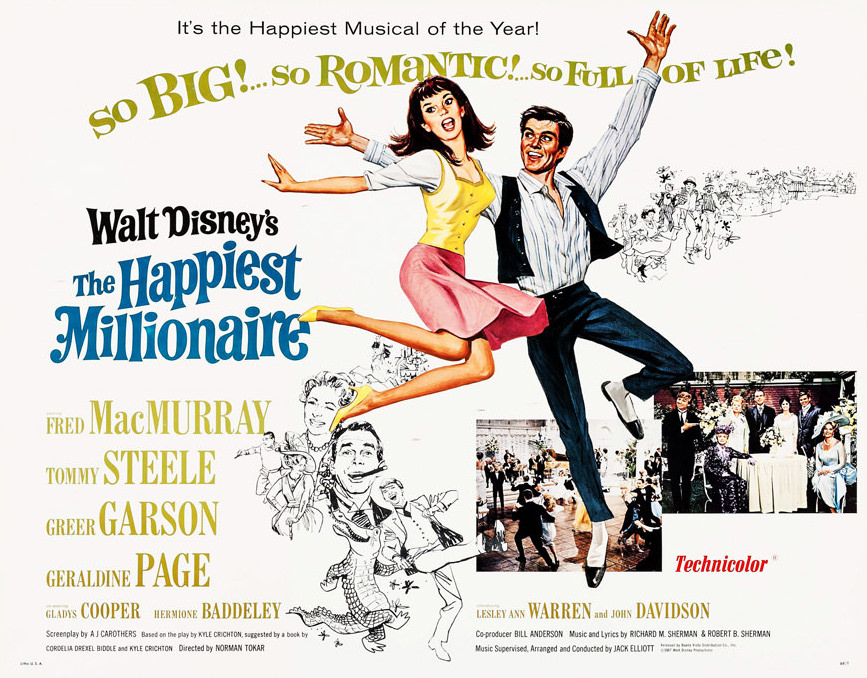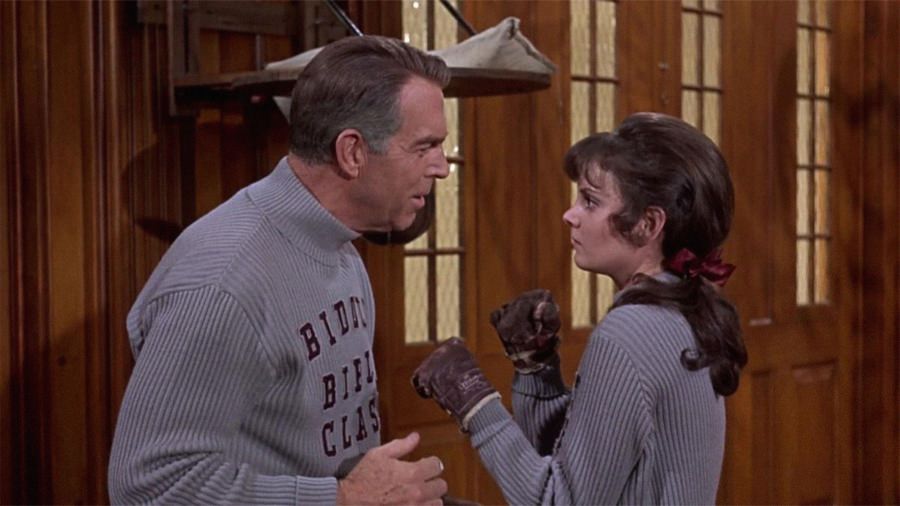The Happiest Millionaire
Directed by Norman Tokar (1967) **
There’s no crime in creating work out of step with the times. Novelist P.G. Wodehouse, while being held captive by Germans during WWII, wrote the whimsical Money in the Bank, about an absent-minded aristocrat disguised as a butler named Cakebread — also featuring “Chimp” Twist and “Soapy” Molloy. Lighthearted silliness in the face of atrocity is an idea at least worth considering, if not championing.
The roadshow musicals of the late ’60s, though (highlighted in Matthew Kennedy’s 2014 book, Roadshow! The Fall of Film Musicals in the 1960s) seemed particularly tone deaf against the background of the Vietnam war and civil unrest because they were nearly all artistically unsuccessful.  Perfection can be an argument against irrelevance, but mediocrity can’t.
Perfection can be an argument against irrelevance, but mediocrity can’t.
Take The Happiest Millionaire, the last live-action film Walt Disney himself had involvement in (he passed away before the film was finished). It’s a movie, over fifty years old, that seemed dated when it was new and takes place in 1916; an antique three times over. Fred MacMurray, who previously played murderers and adulterers, continues his new fatherly image (My Three Sons, The Absent-Minded Professor) as the real-life Anthony Joseph Drexel Biddle Sr. Biddle is the grandson of bankers (though the source of his wealth is never revealed in the film), and uses his home base Philadelphia mansion as training grounds for his “Athletic Christianity” classes, which include boxing. In Disney’s version, he also houses a collection of pet alligators.
The slightly amusing “antics” transpiring in the Biddle household are seen through the eyes of Irish immigrant John Lawless (late ’50s British teen idol Tommy Steele), arriving off the boat for a job. The story’s conflict is: Biddle’s daughter, Cordy (Lesley Ann Warren, in her film debut) wants to go away to college and eventually get married and Biddle doesn’t want to let her go. That’s it. This slight premise somehow gets stretched into a 172-minute experience (including intermission). With its Saturday Evening Post-like credits font,  The Happiest Millionaire wants to evoke the sentimentality of Norman Rockwell, but Rockwell’s best work also had wit and sharp observation, qualities far from view here.
The Happiest Millionaire wants to evoke the sentimentality of Norman Rockwell, but Rockwell’s best work also had wit and sharp observation, qualities far from view here.
Did I mention the film’s a musical? Richard and Robert Sherman, who were ubiquitous in the ’60s, do the honors again here, with poor results. There are thirteen songs to sit through. The film’s most famous song, “Fortuosity”, is another Sherman Brothers earworm, seemingly designed to cause discomfort for weeks. MacMurray can’t sing (this was another inexplicable ’60s film trend) and the bar song “Let’s Have a Drink on It” goes on and on and on. One can’t help but wonder if the film would be better with no songs at all.
A word which justly describes The Happiest Millionaire is: tepid. The directing (by Leave it to Beaver alumni Norman Tokar) is flat, stage-like and generally takes no chances. Biddle’s wife is played by Greer Garson, but she has little to do. John Davidson, as Cordy’s love interest, is bland and boring to the point of fascination: What, you may be thinking, does she find interesting about him? The film ends with rah-rah celebration as Biddle is made a provisional Marine Corps captain so that he can train troops entering WWI. As I said, tone deaf. Maybe The Happiest Millionaire should have been on a double bill with John Wayne’s The Green Berets (1968).
—Michael R. Neno, 2019 September 24